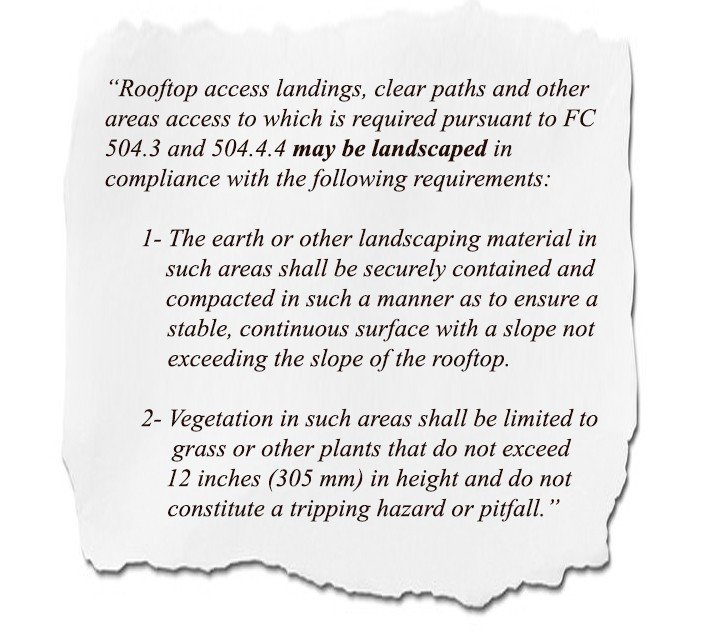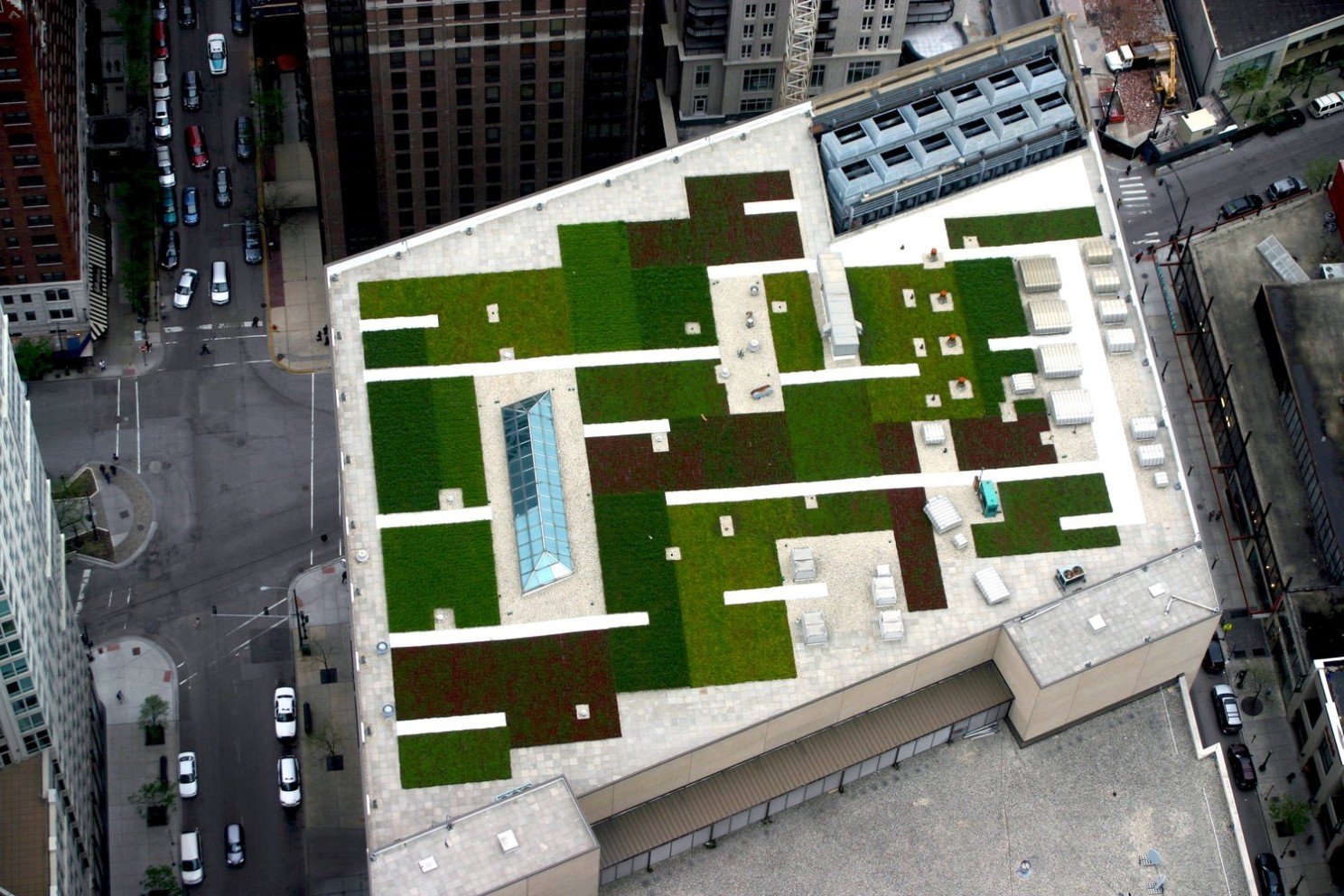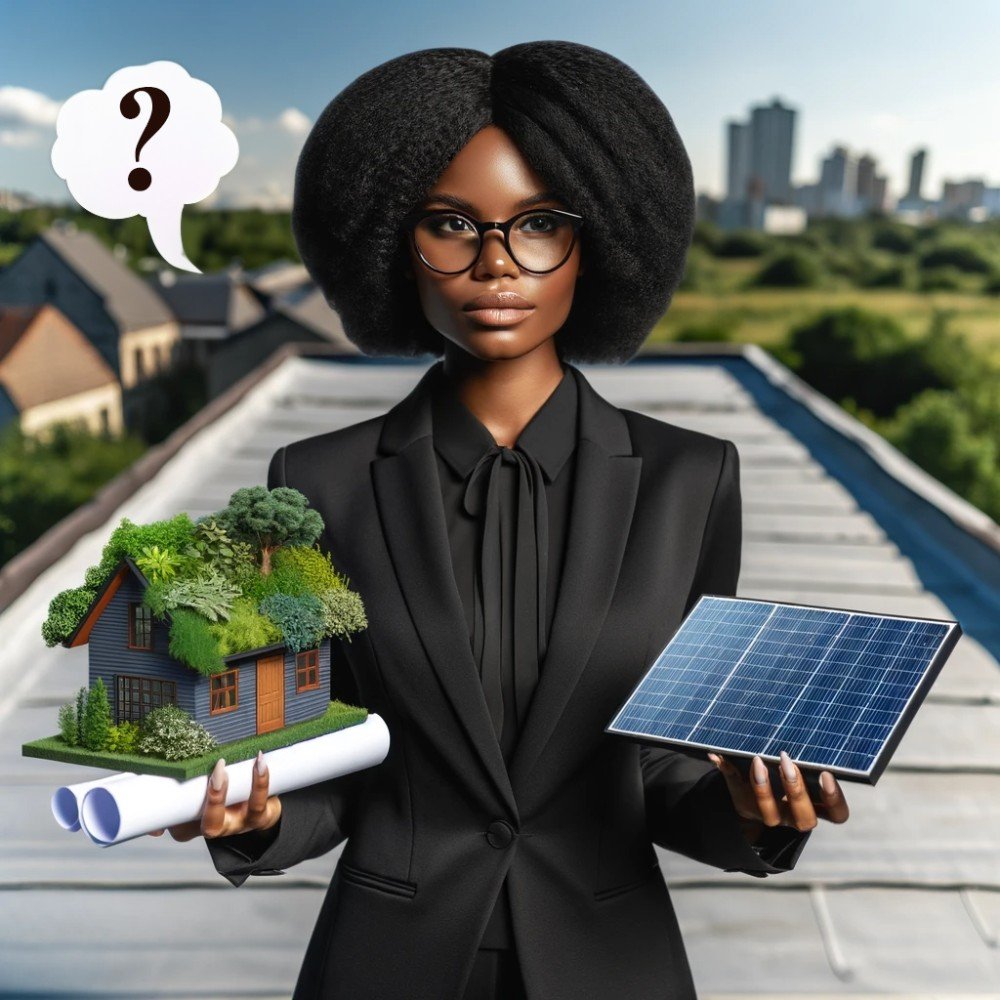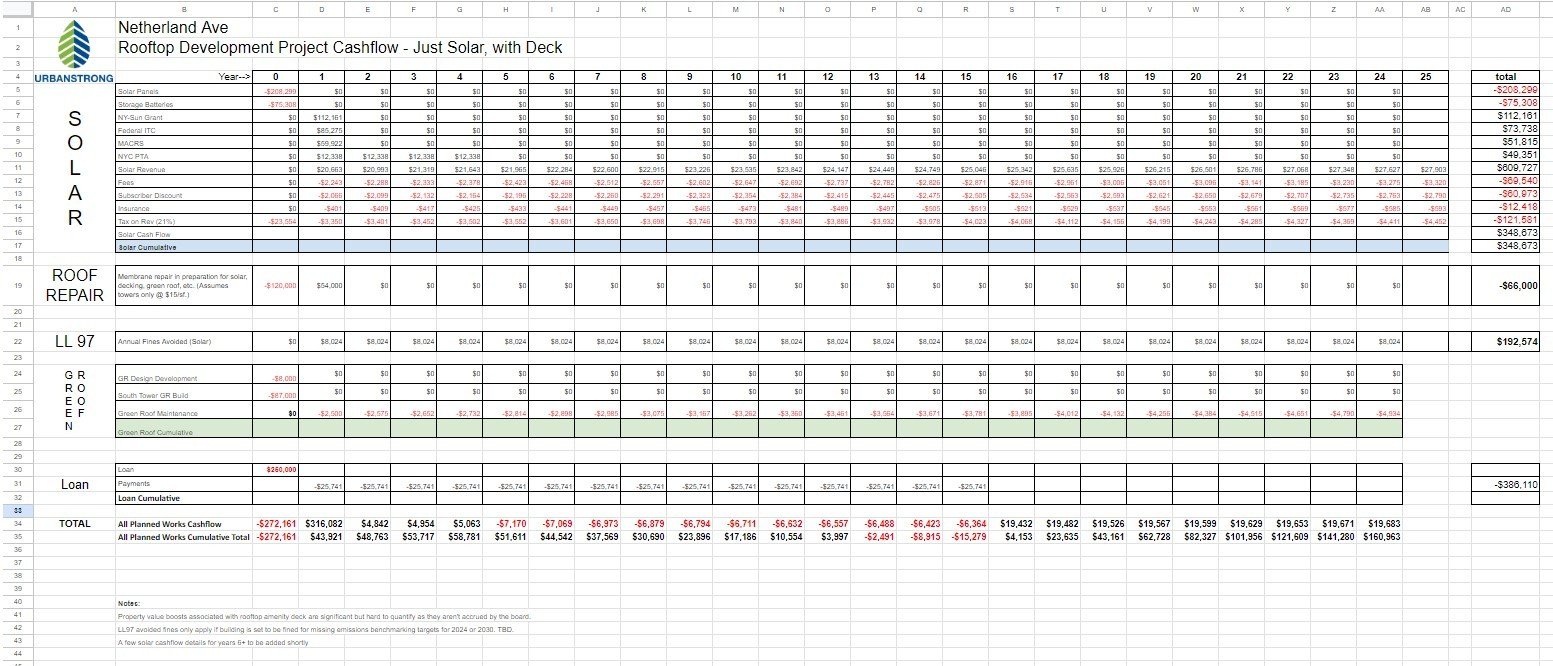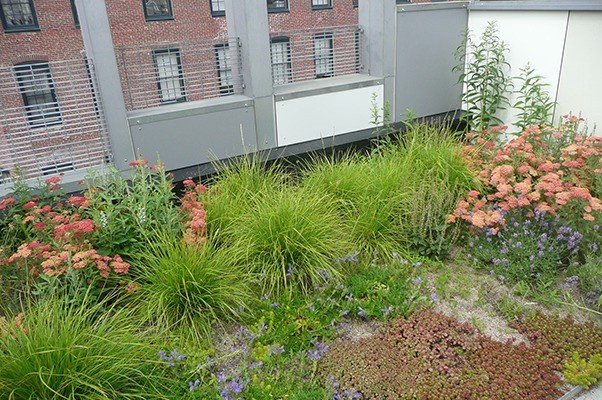An Architect's Guide to NYC LL92/94 Rooftops: Unlocking the Full Potential of Green Roofs and FDNY Pathways
Image by Alan Burchell (with extensive help from ChatGPT 4 and Adobe Photoshop)
Table of Contents Show
Introduction
This blog post sheds light on a commonly misunderstood aspect of New York City architecture: Are green roofs allowed in FDNY pathways, and more importantly, does it make design and economic sense to include them here?
Amidst New York's urban landscape, the integration of firefighter access pathways with green roofs, under Local Laws 92 and 94 (LL92/94), offers an avenue for sustainable and cost-effective design.
Unlike the essential clear pathways required for solar installations, the NYC Building Code permits green roofs to cover the entire rooftop, including FDNY pathways, given adherence to certain standards.
BUT...this flexibility is often missed, leading to a misconception that avoiding vegetation in these areas saves costs. However, this practice results in fragmented green spaces that are actually more expensive to install, aesthetically displeasing and, contrary to belief, more costly in the long run.
Urbanstrong has observed that owners, driven by LL92/94 mandates, often choose not to vegetate FDNY pathways, a decision that undermines the efficiency and financial benefits of a contiguous green roof.
By maximizing rooftop greenery, including FDNY pathways, architects can save their clients money during initial installation, and unlock enhanced stormwater management and energy efficiency, yielding significant long-term savings.
This post delves into blending FDNY requirements with green roofing to achieve designs that are both more economically viable and environmentally beneficial, thus elevating the building's value and contributing to New York City's sustainability initiatives.
LL92/94 Sustainable Roofing Zone and FDNY Pathways
Introduction to LL92/94 Sustainable Roofing Zone
New York City's Local Law 92/94, a pivotal part of the city's environmental policy, mandates the inclusion of sustainable roofing systems on all new constructions and major renovations. A 'sustainable roofing zone' under this law is defined as an area covered by either solar panels or green vegetated roofing, aiming to enhance urban sustainability and environmental resilience.
List of Exclusions in LL92/94
LL92/94 advocates for widespread adoption of sustainable roofing across New York City but specifies certain areas where these requirements are waived. These exceptions include designated recreation spaces for rooftop access, areas housing mechanical equipment, and FDNY pathways.
FDNY pathways, essential for firefighter access and safety, are distinctly excluded from needing sustainable roofing coverage. This exemption underscores the balance urban design must strike between functional requirements and sustainability goals. But as we'll see, the lack of nuance in this broadly worded exclusion is causing confusion, creating a loophole, and removing much of this law's teeth.
A Bronx co-op roof layout showing the FDNY-required 6-foot wide pathways clear of solar panels running along the street-facing edges and across to the stairwell bulkheads.
The Distinction between Solar and Green Roofing in FDNY Pathways
A critical point in LL92/94 is its lack of clear distinction between solar and green roofing within the list of exclusions. While installing solar panels in FDNY pathways is not feasible due to safety and accessibility concerns, the same rationale does not apply to green roofing.
Green roofs, with their low profiles and non-intrusive nature, can be safely and legally incorporated into FDNY pathways, offering an environmentally sound and compliant solution within these excluded zones.
FDNY Regulations and Green Roof Design: Integrating Compliance and Innovation
Navigating FDNY regulations is vital for green roof design in New York City, offering architects and designers the opportunity to create innovative, sustainable, and cost-effective solutions. It's crucial to understand that, contrary to solar panels, the FDNY is receptive to green roofs in their pathway areas.
The NYC Building Code, particularly Section 504.4.9.2, clarifies the integration of landscaped rooftops with FDNY pathways:
Section 504.4.9.2 of the NYC Building Code
This directive is not well known, leading to the false notion that green roofs need clear, non-vegetated pathways like solar installations. However, the Code’s flexibility allows for vegetated pathways, enhancing the roof's environmental impact and visual appeal.
Such design compliance not only meets safety standards but also amplifies ecological benefits, improving stormwater management, urban biodiversity, and energy efficiency.
Further, as we will discuss in a moment, including vegetation across the entire rooftop, FDNY pathways included, actually reduces construction costs and yields long-term financial gains.
Implications of the Current Exclusion Policy
The broad-brush exclusion of FDNY pathways has led to varying interpretations, some of which view it as an opportunity to minimize green roofing under the guise of adhering to the law.
This misconception is often rooted in the belief that less green roofing equates to lower costs. However, this is a short-sighted approach; not maximizing green roof coverage can lead to higher costs due to the need for alternative materials and complex designs.
Moreover, the current policy's lack of distinction between solar and green roofing might inadvertently result in less efficient and environmentally advantageous rooftop designs.
Urbanstrong’s Approach: Maximize Rooftop Greenery to Keep Costs Low
Urbanstrong’s approach to green roof design in New York City combines environmental considerations with astute financial planning. By adhering to FDNY requirements and maximizing green space, Urbanstrong addresses a crucial, often overlooked aspect of green roof design: the hidden costs associated with non-vegetated pathways.
Why are Green Roofs Fragmented with Pathways More Expensive Than Contiguous Ones?
One of the critical challenges that many designers, developers, and building owners overlook is the additional cost incurred by including non-vegetated pathways in green roofs. These areas are typically filled with materials like paver stones or wood deck tiles to protect the roof membrane.
However, these materials are more expensive per square foot, both in terms of purchase and shipping—often requiring separate shipping from green roofing materials. They are also bulkier and heavier, which increases installation costs. And then there’s the edging materials.
Edging is custom-cut on site for each green roof. Photo: Urbanstrong
What is the Purpose of Aluminum Edging on Green Roofs?
Aluminum edging on green roofs serves to contain soil and growing media, maintain clear visual and functional separation between vegetated and non-vegetated zones, and support water management by directing flow towards drainage systems.
It also enhances the aesthetic appeal of the roof by providing a neat, organized look, and contributes to the structural stability and plant health within the green roof system.
This edging is crucial for delineating areas, preventing root encroachment into pathways, and ensuring optimal growth conditions for vegetation.
12” Edge Element for Semi-Intensive Green Roofs
Comparative Example of Continuous vs Fragmented Green Roof
For example, a 50’ x 50’ (2,500 SF) green roof would usually require about 200 feet of edging. However, if the design includes a 6’ non-vegetated path bisecting it vertically and horizontally, it results in four separate 22’ x 22’ green roof sections (1,936 SF), necessitating 352 feet of edging.
This layout not only reduces the beneficial green roof area by 20% but also increases costs by about 5% compared to a contiguous system.
A fragmented green roof on 900 N Michigan in Chicago. Photo: Permaloc Corporation
The Benefits of Full Green Roof Coverage: A Financial Perspective
In New York City, where adherence to Local Law 92/94 is mandatory for building owners, the decision to maximize green roof coverage, including FDNY pathways, offers substantial financial and environmental advantages.
Financial Benefits of Full-Coverage Green Roofs
The economic benefits of fully vegetated green roofs are significant, especially considering the initial and long-term financial aspects. By covering the entire rooftop with vegetation, the need in non-vegetated areas for alternative, more expensive materials, like paver stones and aluminum edging, is eliminated, reducing construction costs.
Over time, vegetated roof areas enhance energy efficiency, leading to lower heating and cooling expenses.
Aesthetic Appeal of Full-Coverage Green Roofs
The aesthetic appeal of green roofs is another factor that contributes to their financial value. A fully vegetated roof, including the FDNY pathways, not only enhances the visual appeal of a building but also potentially increases its market value. This comprehensive approach to greening offers a unique and attractive feature for buildings in the dense urban landscape of New York City.
Environmental Benefits of Full-Coverage Green Roofs
While the financial aspects are pivotal, the environmental benefits of fully vegetated green roofs support their overall value.
A roof with greater vegetative coverage is more effective in managing stormwater, aligning with the NYC Department of Environmental Protection’s Unified Stormwater Rule. This increased capacity for stormwater management not only contributes to urban sustainability but also aids in compliance with on-site stormwater management requirements.
Managing more water on the roof reduces the reliance on costly grey infrastructure that is singular in function. Further, cisterns are costly to purchase and install and often come at an opportunity cost taking up parking spots in underground garages.
Additionally, green roofs help mitigate the urban heat island effect and contribute to urban biodiversity, further underscoring their environmental significance.
For New York City building owners, investing in fully vegetated green roofs represents a strategic decision that aligns with legal requirements while offering financial and environmental returns. The integration of vegetation across the entire rooftop, including FDNY pathways, emerges as a prudent approach in sustainable urban development.
Which Is More Financially Beneficial Under LL92/94: Green Roofs or Solar Panels?
Now that we've proven designers are allowed to vegetate inside the FDNY pathway, should they?
"Just because you can, doesn't mean you should."
While we at Urbanstrong have a strong affinity for green infrastructure's multifaceted vegetated solutions, practical considerations sometimes tilt the balance toward solar panels for certain projects. Factors such as budget constraints, available incentives, or the building's structural capacity often guide this decision.
Image by Alan Burchell via DALL·E and Photoshop
For property owners focused strictly on financial returns, solar panels are typically the preferred choice, assuming their rooftops receive sufficient sunlight. In New York City, the challenge of overshadowing by adjacent buildings often renders solar panels economically unviable. Under LL92/94, if 4kW of solar capacity cannot be achieved, owners must then install a green roof for their 'sustainable roofing zone,' provided the capacity is there and the slope is not too great.
On the other hand, the installation of a green roof, especially one accessible as an amenity space, can significantly increase the value of individual units in a cooperative building, according to historical real estate data. When taken building-wide, a co-op board must realize that such an enhancement can swiftly accumulate, potentially surpassing the long-term financial benefits of solar arrays.
Further, some buildings are now required to first consider green infrastructure solutions, like green roofs, in order to meet their on site stormwater management requirements, as part of the NYC Department of Environmental Protection's new Unified Stormwater Rule. So selecting a green for to also comply with the Local Law 92/94 Sustainable Roofing Zone requirement may feed two birds with one scone.
However, not all roof structures are suitable for green roofs, especially those intended for public use, or they may lack necessary egress or not comply with the Americans with Disabilities Act (ADA) requirements. In such cases, solar becomes the more feasible option.
If this all seems a bit overwhelming, designers can rest assured that as part of Urbanstrong’s Rooftop Development Consulting Service, we delve into our clients’ project ambitions, financial landscape, existing infrastructure, applicable local laws and available incentives. Our objective is to facilitate informed, financially prudent decisions, employing 25-year comparative cash flow analyses for each scenario under consideration.
Sample 25-Year Project Cashflow Comparing Bronx Rooftop Development Options - via Urbanstrong Consulting
Urbanstrong’s Recommended Sustainable Roofing Zone Green Roof Design Strategy
Urbanstrong recommends a design approach that maximizes vegetative coverage up to the parapet, aligning with the specific roof membrane manufacturer’s warranty requirements. While some membranes require a 12-18" wide non-vegetative zone along the points where a green roof meets the edge of a membrane, others allow extending the greenery right up to the parapet or roof edge.
Green Roof without a Non-Vegetated Zone at roof edge.
This approach not only maximizes the green area but also eliminates the need for additional materials like perforated edging for flashing.
By choosing membranes that do not necessitate a non-vegetative zone, Urbanstrong’s strategy offers both environmental and financial benefits.
It reduces initial construction costs and long-term maintenance expenses, making green roofs a more attractive investment for real estate developers and owners concerned about payback times. (Note: Urbanstrong has relationships with several major manufacturers of such membranes and can offer owners a Single-Source Warranty covering both the membrane AND green roofing together).
That said, Urbanstrong's urge to designers is to ignore the option to not vegetate FDNY pathways even though the LL92/94 language permits it. Ideally the City would remove FDNY pathways from the list of areas that can be excluded from the LL92/94 Sustainable Roofing zone, for green roofs only.
Again, solar should never be placed in an FDNY pathway.
In essence, Urbanstrong’s approach to green roof design in New York City is a blend of maximizing greenery while being mindful of both environmental benefits and financial practicality. This method ensures compliance with safety standards and leverages the full potential of green roofs, making them a sustainable and cost-effective option in urban architecture.
Conclusion
This exploration into green roof design in New York City underscores the importance of adhering to the NYC Building Code while maximizing green space.
“Just because you can, doesn’t mean you should.”
Emphasizing full green roof coverage, including inside FDNY pathways even if a language loophole permits you an excuse not to, offers a practical balance between environmental stewardship and financial viability.
The integration of vegetated pathways leads to cost-effective design solutions, addressing hidden expenses associated with non-vegetated areas and enhancing energy efficiency.
Such designs not only comply with Local Laws 92 and 94 but also contribute to improved stormwater management and urban biodiversity.
This approach aligns with the city's sustainability goals, offering a blueprint for creating green spaces that are efficient, visually appealing, and financially sound.
In summary, by adopting these strategies, architects and designers can create high-performing LL92/94 compliant green roofs that maximize building owners' return on investment.
TL;DR
Urbanstrong's urge to designers is to ignore the option to not vegetate FDNY pathways even though the LL92/94 language permits it. Ideally the City would remove FDNY pathways from the list of areas that can be excluded from the LL92/94 Sustainable Roofing zone, for green roofs only. Again, solar should never be placed in an FDNY pathway.
Afterword: Urbanstrong’s Green Roof Services and Design Approach
Urbanstrong’s approach in green roof design blends FDNY compliance with maximizing rooftop greenery, deeply rooted in sustainable urban design. Our comprehensive services encompass everything from initial concept and design to installation and ongoing maintenance, tailored to meet each client’s unique needs.
Comprehensive Services with Innovative Solutions
Urbanstrong offers a 'soup-to-nuts' service approach, covering all phases of green roof development, including innovative solutions for green roofing, solar, stormwater management, farms, amenity spaces, or hybrid systems.
Our design philosophy integrates advanced materials and plant selections ideal for rooftop conditions, focusing on space optimization and safety.
Consulting for Financial and Legal Compliance
Urbanstrong also provides consulting on financial aspects of rooftop development, assisting clients in securing grants, financing, and incentives. We ensure that rooftop designs drive compliance with local laws like NYC Local Law 92/94, and 97, making green roofs a viable and strategic investment.
Our expertise helps clients navigate these legal requirements effectively.
Emphasis on Sustainability and Biodiversity
Sustainability is at the forefront of our approach. We select drought-resistant plants and use eco-friendly materials, prioritizing local plant species that benefit pollinators, birds, bats, bees, and butterflies.
This commitment to biodiversity enhances the ecological value of urban spaces.
Urbanstrong is dedicated to transforming urban landscapes into sustainable ecosystems that are not only compliant with regulations but also contribute positively to the city’s environmental health and community well-being.




